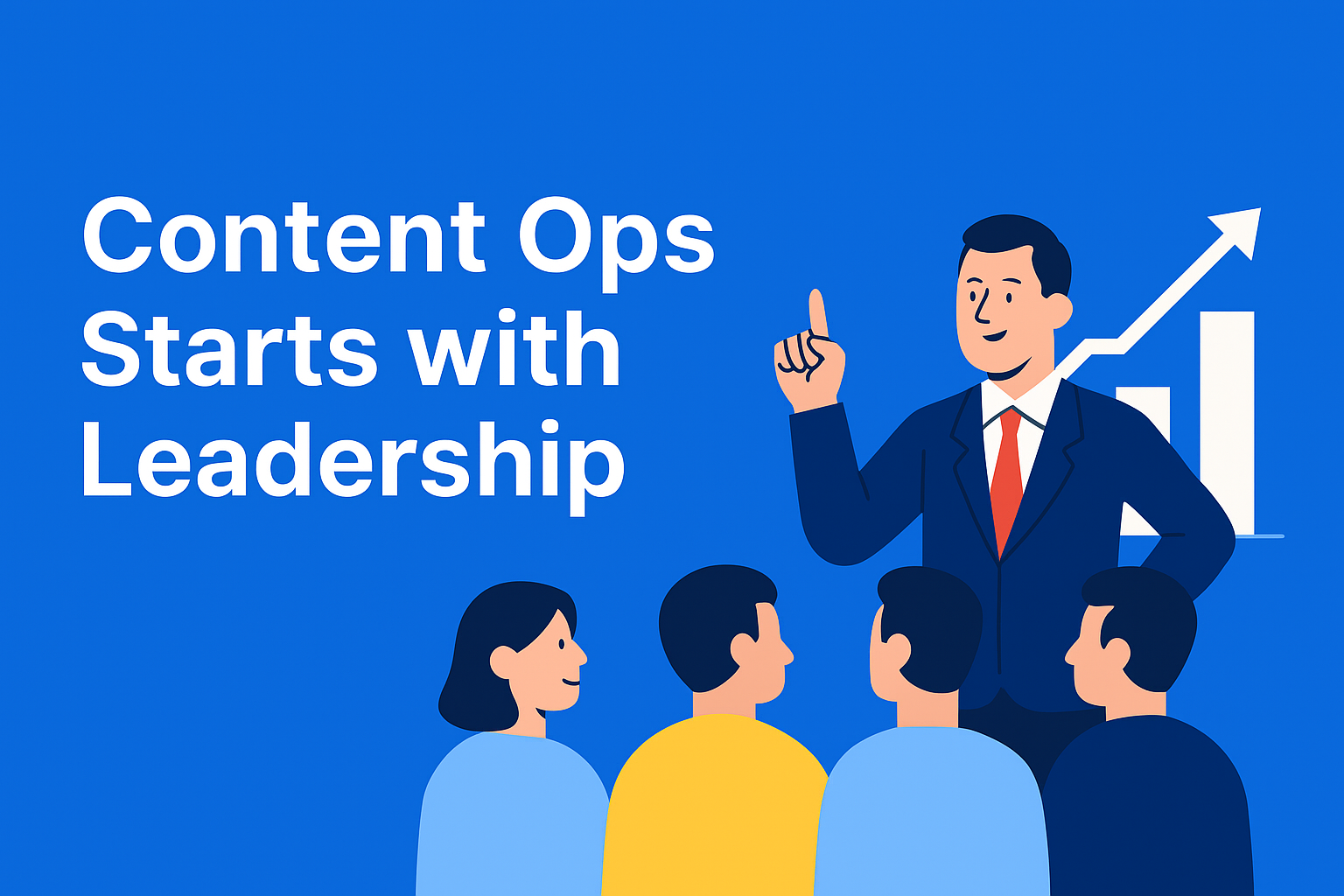Why Content Ops Is a Leadership Problem, Not a Workflow Problem
Content Ops isn't just about better tools or faster workflows, it's about leadership. Without clear ownership and strategic direction, content teams stay stuck in chaos. Discover why leadership is the missing link in scaling your content operations.

Let’s be honest. Most conversations about content operations still revolve around tools, templates, and workflows. We hear things like "We need a better content calendar" or "Our approval process is too slow." Sure, those things matter. But if your content engine keeps stalling no matter how many new tools you throw at it, it’s time to zoom out.
Here’s the real issue: Content Ops is not a tooling problem. It’s a leadership problem.
And as long as leadership treats it like a secondary issue, content teams will stay stuck in reactive mode-overworked, misaligned, and creating content that never truly delivers results.
Key Takeaways
- Content Ops is a leadership issue, not just a tooling one. Without strategic ownership, even the best workflows become structured chaos.
- Good leadership defines a content mission that links content to business goals like revenue, retention, or adoption-not just traffic.
- Clear ownership and accountability ensure deadlines are met, feedback is useful, and roles aren’t duplicated or lost in silos.
- Tools don’t fix misalignment. Platforms like EasyContent help only when direction, purpose, and structure are defined from the top down.
- Content strategy requires executive support. CMOs and leaders must treat content as a core business asset-not a side task for marketing.
What Content Operations Really Means
Let’s quickly define things. Content Operations is not just about publishing a blog post. It’s an end-to-end system that enables your organization to create, manage, distribute, and optimize content consistently across teams, channels, and formats.
It includes:
- Strategic alignment
- Allocation of people and budget
- Approval processes and governance
- Editorial calendars
- Tools, platforms, and people
It touches marketing, product, sales, legal, brand, and more. When it works, content moves from chaotic output to strategic asset.
That’s why treating it purely as a workflow problem misses the bigger picture.
The Workflow Trap: Why “Fix the Process” Fails
We’ve all been there. A campaign is late, and the knee-jerk reaction is: "We need a better process." So we add another tool. Or another spreadsheet. Maybe even a new project manager.
But if no one owns the bigger picture-why content is being created, what purpose it serves, what impact it should have-then no tool will save you. Workflow without strategic leadership is just structured chaos.
Symptoms are easy to misread. The issue isn’t slow approvals. The issue is no one knows who makes the final call or what “done” even means.
Without strong content leadership, what gets published is often safe, generic, or misaligned with business goals. Your content becomes busywork instead of a growth driver.
Content Ops Needs a Leadership Mindset
When Content Ops works, it’s because leadership steps up. Not just the Head of Content or Content Strategist, but also the CMO, VP of Marketing, even the Chief Revenue Officer.
Leadership is not about sign-off. It’s about owning the content vision.
You need someone to:
- Champion content as a business asset
- Define strategic priorities
- Align teams around messaging and goals
- Create accountability
- Eliminate friction across departments
Content needs an internal advocate with enough influence to connect the dots across silos. Especially when your content supports revenue, customer education, and brand awareness all at once.
In many companies, a lack of leadership leads to bloated content libraries, inconsistent tone, and team burnout.
What Good Leadership Looks Like in Content Ops
This isn’t about micromanaging Trello boards. It’s about setting the foundation so your team can actually deliver.
Here’s what strong leadership in Content Ops brings:
1. A Clear Content Mission
Why does this team even create content? What does success look like-beyond just pageviews?
Strong leaders tie content back to business goals: lead generation, product adoption, customer retention. And they reinforce that vision constantly.
2. Ownership That Makes Sense
You’d be surprised how many teams operate without a true content owner. Not just a manager, but someone with strategic authority.
When ownership is clear, roles don’t overlap. Deadlines are met. People know when to escalate issues.
3. Realistic Resources
Too many content teams are expected to deliver big results with two writers and no budget. Leaders should plan like they would for any critical function-enough people, clear priorities, and tools that actually make work easier.
Platforms like EasyContent can help centralize workflows and improve collaboration-but only after leadership defines the strategic direction.
4. Culture of Accountability
This is key. When people know they’ll be accountable for content performance, quality improves. But accountability has to come from the top-not just a checklist.
Two Stories: One With Leadership, One Without
Let’s compare.
Company A invests in a fancy new CMS, calendar tools, and AI plugins. But their strategy lives in a PowerPoint no one opens. Content briefs are vague, review cycles endless, and no one really knows what happens to content after it’s published.
Company B doesn’t have expensive tools, but the CMO defined a content mission, empowered a Director of Content, and aligned sales, product, and marketing on a shared message. They focus on outcomes, not just volume.
Guess which company sees real ROI from content?
If You’re in Leadership, Start Here
You don’t need a fully built-out Content Ops department right away. But you do need to start treating content like a serious investment.
- Audit your existing workflows. Where are people getting stuck?
- Identify who actually owns your content strategy.
- Set clear business goals for content.
- Cut unnecessary steps.
- Invest in tools after aligning people and purpose.
That’s how you move from reactive to strategic Content Ops.
And if you’re a content manager or team lead: now’s your chance to advocate for change. Bring leadership into the conversation. Show them this isn’t about churning out more content-it’s about building a content system that scales.
Final Thought: Leadership First, Tools Second
We’ve worked with teams at all stages of Content Ops maturity, and one thing is clear: tools amplify clarity; they don’t create it.
That’s why EasyContent wasn’t built to replace your strategy-but to support it. Once you’ve defined your leadership model, platforms like ours help you bring structure to your strategy-not the other way around.
If your team is still stuck in content chaos, don’t rush to change tools. First ask: Who’s leading this?






